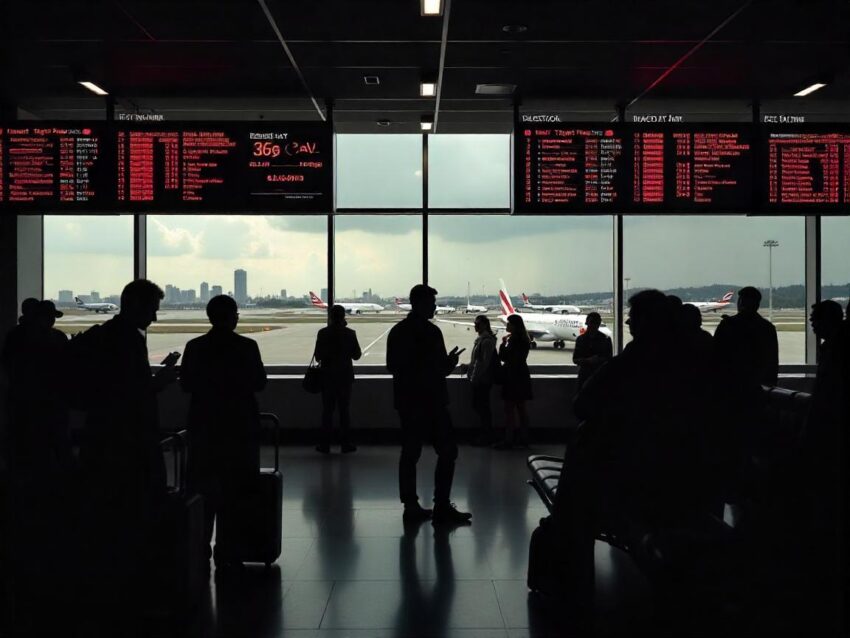
Southwest, along with American, United, Delta, Frontier, Alaska, JetBlue, Spirit, and more, faced a massive operational test this Memorial Day weekend. With more than sixteen thousand flights delayed, the skies over Dallas, Newark, San Francisco, and Colorado turned chaotic as storms and staffing shortages collided with record-breaking passenger demand.
Meanwhile, passengers at airports across the country found themselves grounded, rerouted, or waiting in frustration. These weren’t isolated delays—they were part of a nationwide disruption that impacted nearly every major U.S. carrier. From Southwest to Spirit, and from United to Delta, the ripple effects were felt far and wide.
As travelers tried to reach holiday destinations, airports like Dallas-Fort Worth, Newark Liberty, San Francisco International, and Denver in Colorado emerged as flashpoints of delay and disruption. American Airlines, JetBlue, and Alaska struggled to recover as ground crews worked around the clock.
But the weather wasn’t the only culprit. The scale of Memorial Day travel in 2025 has surpassed previous years, putting intense pressure on already stretched airline operations. More than sixteen thousand flights delayed tells only part of the story.
So what’s really happening behind the scenes? Why are so many flights—across Southwest, United, Frontier, and more—being held up? And how are travelers coping in the middle of one of the busiest travel weekends in recent U.S. history?
Stay with us. Because this isn’t just a travel hiccup—it’s a storm of logistics, demand, and human patience colliding in real time.
A dramatic weather event shook Memorial Day weekend as a Southwest Airlines flight bound for Denver International Airport was struck by lightning during its final approach. The incident occurred on Sunday, May 25, 2025, while severe storms rolled through much of the southern and central United States.
Southwest Flight 168, en route from Tampa to Denver, experienced the lightning strike as it descended into storm-lashed airspace. Emergency crews responded swiftly as the plane landed without incident. Thankfully, all passengers and crew were unharmed.
However, the aircraft was immediately removed from service for inspection. Maintenance teams are currently evaluating the full extent of the potential damage, while the airline navigates increasing pressure during a peak travel weekend.
Storms Hammer Travel Across the Nation
This wasn’t an isolated weather scare. The broader Memorial Day weekend was marked by chaotic weather patterns, causing ripple effects across the U.S. aviation system. More than 2,700 flights were delayed on Monday alone, with dozens more canceled, according to real-time data from FlightAware.
Dallas-Fort Worth emerged as one of the hardest-hit airports. Torrential rain and strong winds disrupted both arrivals and departures, creating widespread frustration among travelers eager to kick off the unofficial start of summer.
Texas continues to reel from days of thunderstorms, and meteorologists warn that the severe weather will persist into Tuesday. This prolonged instability poses ongoing risks for flight schedules and passenger safety.
Lightning Adds to the Pressure of Memorial Day Travel
Memorial Day weekend always brings pressure to the aviation sector. But 2025 is setting new records. According to AAA, over 45.1 million Americans were expected to travel at least 50 miles during the long weekend—1.4 million more than in 2024.
This year also marked a significant policy shift. It was the first Memorial Day that U.S. travelers needed a REAL ID or passport to board domestic flights. The rollout added another layer of complexity to already overwhelmed airport operations.
For Southwest and other major carriers, the weather event served as a sobering reminder of the fragility of air travel during peak seasons. Though the aircraft landed safely, it highlights how even one incident can intensify operational challenges.
Resilient Infrastructure Faces Real-Time Test
Denver International Airport, one of the busiest hubs in the country, activated emergency response protocols and worked in coordination with airline staff to ensure passenger safety and aircraft integrity.
While the event passed without injury, the optics of lightning against a backdrop of holiday storms added visible tension to a weekend already strained by volume and weather.
Industry Impacts and Traveler Sentiment
As summer officially kicks off, this incident underscores the need for resilient operations, updated communication systems, and real-time decision-making in airline control centers.
Travelers, meanwhile, expressed growing concern over delays, with many turning to travel insurance and flexible booking options. Social media buzzed with firsthand accounts and calls for clearer weather preparedness measures.
Looking Ahead: What This Means for Summer Travel
With summer travel entering full swing, airlines will be tested on multiple fronts. From extreme weather to new ID requirements, the pressure to maintain reliability has never been higher.
Carriers like Southwest must now focus on building trust. Transparency, proactive updates, and smooth customer service will be critical.
For passengers, this is a moment to stay vigilant. Monitor flights, plan for contingencies, and stay informed about weather disruptions.
Memorial Day 2025 was meant to mark a return to joyful travel. Instead, it has raised important questions about the industry’s readiness for a rapidly changing climate and evolving passenger expectations.
The post Southwest with American, United, Delta, Frontier, Alaska, JetBlue, Spirit and More Than Sixteen Thousand Flights Delayed in Dallas, Newark, San Francisco, Colorado During Memorial Day Travel, Latest Update Till Now appeared first on Travel And Tour World.